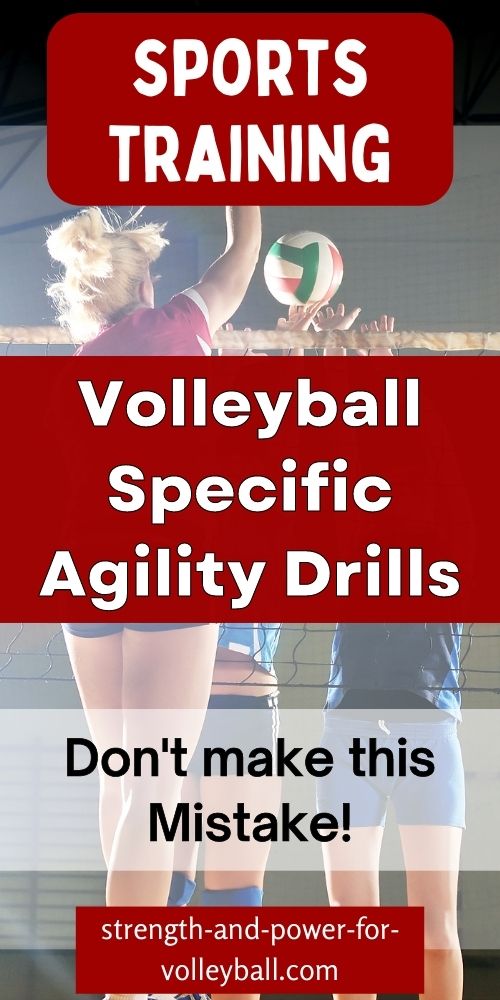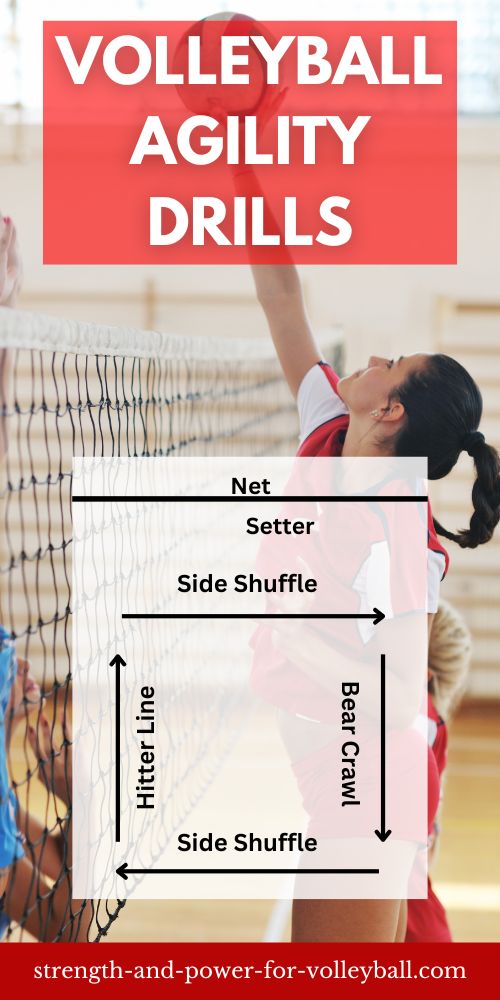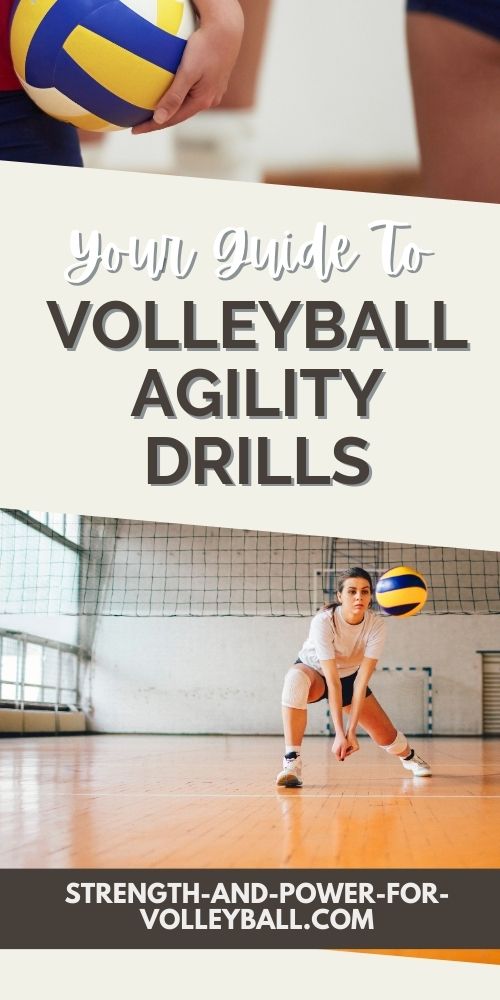- Home
- Conditioning
- volleyball agility drills
Volleyball Agility Drills
Sport Specific Agility/Conditioning
Why do volleyball agility drills?
When passing or playing defense, the most important athletic move a volleyball player needs to make is to slow down and get in position to make the play.
Some would say you could define how athletic a volleyball player is by how fast they can come to a stop and change direction.
Being able to quickly and safely slow down and change direction is essential to making athletic plays on the volleyball court.
Volleyball players that perform volleyball agility drills see improvements in balance, stability, coordination, and body control.
Agility drills can also be used to increase power endurance, not just working the anaerobic energy system, but also the aerobic energy system.
This means agility drills can be used for volleyball conditioning that will help volleyball players continue to perform at a high level for longer periods.
High-intensity agility drills challenge the cardiovascular system. The result is better stamina and a faster recovery.
This faster recover is critical for intense volleyball matches and grueling all day tournaments.
The Best Type of Volleyball Agility Drills
I believe it's important conditioning needs to be as sport-specific as possible.
For example, consider how far players must move to make plays. Also, consider how long athletes work compared to how much rest they have to recover for the next bout of work.
The average length of plays in volleyball are 4 to 6 seconds with an average of 11 to 16 seconds rest between plays.
So, consider the work:rest ratio when designing your volleyball conditioning for your team.
The distance players travel is usually just a few steps. The volleyball court is 30 feet by 30 feet and most of the time players won't be traveling all the way across the court to make plays.
In serve receive, the receiver only needs a couple steps to get to the ball.
On defense, the defender may take a few steps or maybe none at all.
When approaching to spike, the attacker takes 3 or 4 steps.
A blocker will take just a few steps laterally.
Consider these movements when designing your agility drills for your team.
For volleyball, it makes the most sense to design drills that involve quick foot movements and first step quickness sense these are the movements most important for volleyball players.
Have you ever searched online for agility drills and you come across drills that involve athletes sprinting for 20 yards, then making a quick change of direction move? Have you consider how relevant (or irrelevant) this type of drill is for volleyball? Does a volleyball player benefit by training like that? I think we can come up with agility drills that are more specific to volleyball.
Volleyball Agility Drills within Skills Training and Team Practice
When it comes to agility, I believe it's best to combine agility training with volleyball training.
I usually don't recommend doing a separate agility without.
Most teams don't have a lot of time to practice.
Most often there isn't enough time to separate sports conditioning from volleyball practicing.
The basic skills and focusing on team practice are the most important part of improving at volleyball.
So, I like to combine agility drills within my volleyball drills.
It's usually more time efficient to create team practices that combine the conditioning with the skills/team practice.
For example, most teams spend so much time hitting and blocking, there just isn't enough time to recover for a series of agility drills that are specific to conditioning for volleyball.
That's why I usually recommend focusing on implementing a volleyball practice that will include the conditioning within volleyball skills training.
There are situations where it makes sense to do conditioning separate from volleyball such as off-season.
Or if you play college volleyball, your team may have time to train every single day.
But for most of us, we don't have much time. And most of us need more time to recover.
And the key to improving quickly is recovering quickly from your training.
Don't make the mistake of training skills while you're tired.
Performing skills when fatigued can lead to injuries and also create bad habits.
Volleyball Agility Drills within Volleyball Drills
Here are some suggestions for combining agility within volleyball drills.
These drills improve the ability to change direction, control body position, cutting ability, and ability to transition between skills.
For the square drills, you need 4 cones. If you don't have cones available, use court tape or court markings.
Place the first cone at center of the 3 meter line. Place the second cone at the intersection of right side line and 3 meter line. Place the 3rd cone is at the intersection of the endline and sideline. Place the 4th cone in the center of the endline.
Form an attacking line of outside hitters.
The setter is at the net ready to set.
Have the rest of the team shag the hits.
Each drill starts by the player tossing the ball to the setter. The setter sets the hitter. The player takes an approach and spikes the ball.
So, each drill starts with an approach to attack by the first player in line. Immediately after the spike, the next player in line tosses a ball and takes the approach and spikes. Players continue to rotate into the drill. Do this for the following 3 drills.
Drill 1. Square Drill - Shuffle Drill, Bear Crawl
After the hit, side shuffle from the first cone to the second cone. Next, bear crawl to the third cone. Last, side shuffle to the last cone.
The player then returns to the end of the line of attackers and prepares to perform the drill again.
Drill 2. Square Drill - Carioca, Backpedal
After the hit, carioca from the first cone to the second cone. Next, back pedal to the third cone. Last, carioca to the last cone.
The player then returns to the end of the line of attackers and prepares to perform the drill again.
Drill 3. Square Drill - Single Leg Hop, Backpedal
After the hit, single leg hop from the first cone to the second cone. Next, backpedal to the third cone. Last, single leg hop on the other foot to the last cone.
The player then returns to the end of the line of attackers and prepares to perform the drill again.
4 Agility Drills With Serve Receive
On Stomach Drills
Drill 1. In zone 1, have the receiver get down on the floor positioned on the stomach. The drill starts by quickly getting up in a ready position to receive the serve. The server on the opposite side of the net serves the ball and the receiver passes the ball to the target.
Repeat the drill with the next player in line.
Drill 2. Same as first drill but from zone 6.
Drill 3. Same as first drill but from zone 5.
Fast Feet Drills
These drills involve the two foot skier movement.
Drill 1. Form a line of receivers near the net in zone 4. First player performs the two foot skier movement forward half way down the sideline. Once reaching half way, the receiver quickly steps onto the court ready to receive the serve. The ball is served and the receiver passes to the target.
Drill 2. Same as drill 1, this time perform the drill starting in zone 2.
Drill 3. Same as drill 1, this time perform the skier backwards coming from zone 4.
Drill 4. Same as previous drill, this time perform the drill backwards coming from zone 2.
Volleyball Agility Drills After a Dynamic Warm Up
I'm sure you're like me and feel you only have so much time to practice. If you don't want agility drills to take too much time away from your volleyball practice time, then one option is to perform volleyball agility drills at the end of your dynamic warm up.
In just a few minutes of time, it's can be well worth the work.
Here's something your team can do.
Use the court lines. Divide your team up into two groups. Use the 3 meter line and end line for the drills. Basically, you're performing the drills from one side of the court to the other. Have each player follow one another.
After your dynamic warm up, perform these drills.
- Forward Skier
- Backward Skier
- Single Leg Bounding Forward
- Single Leg Bounding Backward
- Single leg skips (Start from a position on the floor, flat on your stomach)
- Two leg skips (Start from a position on the floor, flat on your stomach)
If you enjoyed these tips and would like to keep it close to you at any time, just save this pin to your Pinterest Volleyball Training Board.


